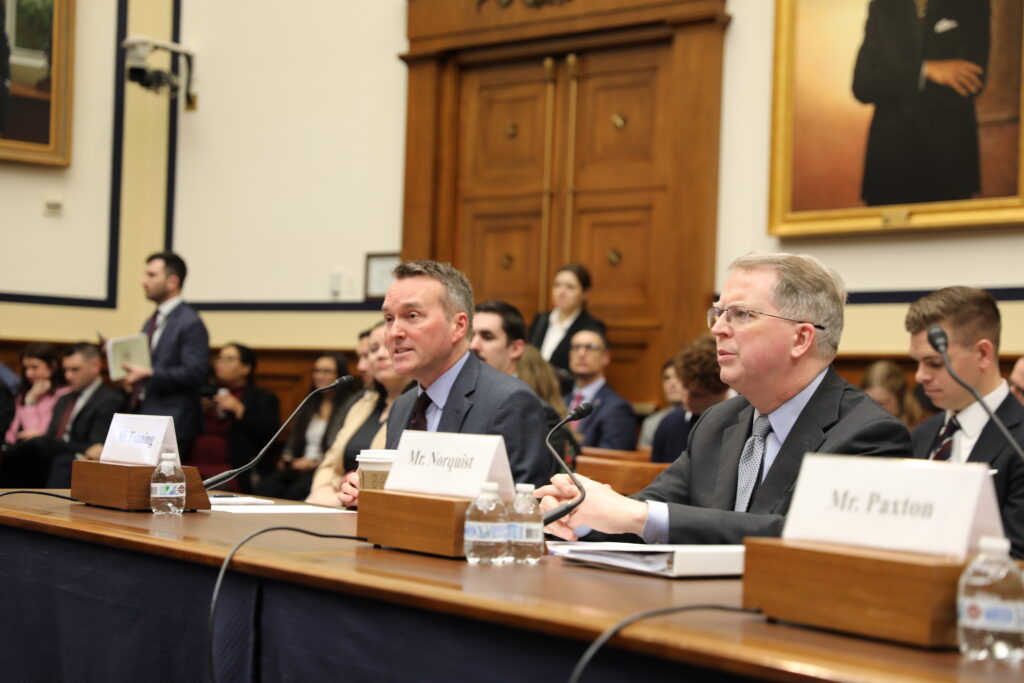Arlington, Va. – In case you missed it, this week the Aerospace Industries Association (AIA) President and CEO Eric Fanning testified before the House Armed Services Committee in a hearing focused on strengthening the defense industrial base and its ecosystem. Here are eight takeaways from the hearing.
1. The defense industrial base is a complex ecosystem of companies, and Congress should take an “all-of-the-above” approach to reforming the acquisition process – empowering the entire base to better meet the needs of the warfighter and nation.
“Every morning, more than two million Americans employed by the aerospace and defense industry go to work with one mission in mind: to enhance deterrence by increasing the lethality, survivability, and chance of victory for the warfighter… However we proceed, we must take an all-of-the-above approach to defense acquisition – recognizing that the defense industrial base is a diverse ecosystem of companies that each have an important role to play. We must ensure the system positions the whole industrial base – primes, new entrants, suppliers, and commercial companies of all sizes – to meet the warfighter’s needs and the nation’s expectations.”
2. Transforming the acquisition process will get capabilities to the warfighter quicker, but it will take review at every level.
“I think there are different categories here. Regulations are a requirement that could be changed right away. For example, cost and pricing data, raising the threshold there. Providing costing data that has been validated by one company across the entire defense industrial base. There are a lot of different things I think we can do now for efficiency, but the entire system needs to be reviewed because it has been built in an additive way for many years. There is no silver bullet to fix this system.”
3. Continuing resolutions and constant appropriation uncertainty injects unnecessary risk into the defense industrial base, harming especially the supply chain.
“If I only had one headline for what we need for the defense industrial base is that we need a clear, consistent and sufficient demands signals so that the industrial base and the private capital that supports it can line up for DOD requirements.”
“A year-long CR is particularly disruptive especially if it has limited anomalies. New programs don’t start…if there is a new start and companies have invested in it all up and down the supply chain — workforce, the materials, the parts — it’s a tremendous financial hit on them —especially on small companies that don’t have the cash flow or access to capital to withstand that type of delay. This is what feeds into having that consistent signal from the government so that all of that is required to produce what the government needs when it needs it takes place. In a way it causes a disruption not only in building those supply chains, it causes a disruption in trust for the companies large, small, in between to lean forward and invest and be ready because they do that, they all do that.”
4. Securing supply of critical minerals should be a top priority for Congress.
“Critical minerals are one of our key priorities in industry and in Congress to make sure that we source them better internationally. We should just be realistic that these are expensive to mine and very difficult to process, so it’s going to take an investment to get that started so that we can source them in a smarter way for the United States.”
5. Drawing from the deepest pool of workers only helps hire and retain the best workforce, creating high-skill jobs that pay better.
“We know that we have jobs that pay 50 percent more than the national average and we have to pay well, we need that type of a workforce…we need to have that pipeline that feeds into STEM that can be this type of high-skilled labor where we can recruit and grow.”
6. Small businesses are especially susceptible to the negative repercussions of inconsistent demand signals, and major disruptions can cause them to leave the defense industrial base altogether.
“Small businesses in particular are operating on smaller margins and with fewer resources and tools to get them over primes in the system…Anything we can do to be consistent in our timelines and how we deliver in programs and how we deliver on contracts to conduct those payments helps small businesses.”
7. Reallocation of spectrum — especially in the S-band, on which many critical weapons systems rely — should be done thoughtfully to mitigate risk, understand the cost, and enhance capabilities.
“Spectrum is a longstanding, very important issue. We all benefit from having more entities in the spectrum, we benefit in many ways, but when it impacts the DOD, we have to be cautious about it. There will a tremendous expense with the DOD and that will be a taxpayer expense that we need to take into account and should come out of auction proceeds that come from selling that spectrum. So, I caution that we do this very carefully, — smart people make smart solutions. But, just like civil aviation, the risk for the DOD is higher than any other industry that is going to be in spectrum.”
8. To deter our adversaries and increase innovation, restoring the research and development tax credit is imperative.
“In the previous round of tax reform, they switched or, I should say, sunset the R&D tax amortization where if you spent a dollar in a year, you got to deduct that in that year to a five-year amortization. At the same time, China doubled it. They gave you a 20 percent deduction for every investment you made in R&D in real time. This affects not only big companies, but very small companies that were doing R&D that had to stop doing it. They can’t afford what becomes the luxury of R&D investments.”
###


